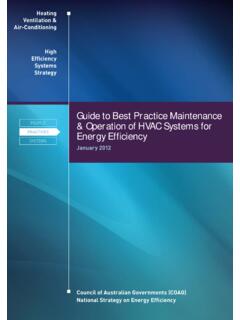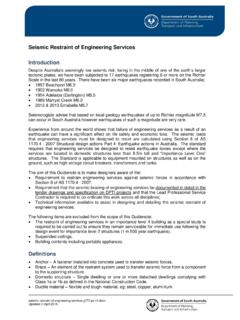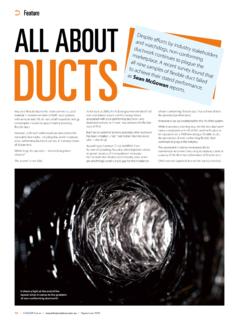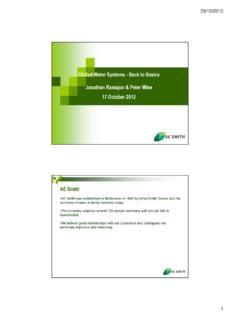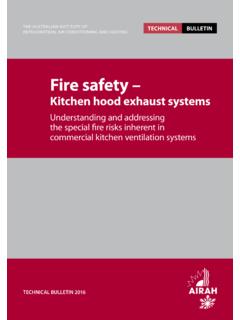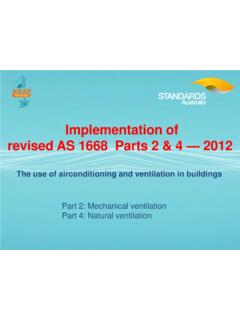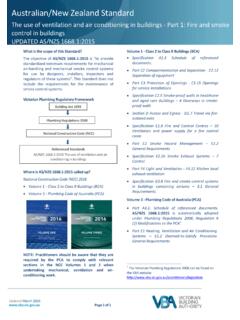Transcription of AIR CONDITIONING RESIDENTIAL BEST PRACTICE …
1 AIR CONDITIONING RESIDENTIAL best PRACTICE GUIDELINE (Victoria) Compiled and written by: Laurie Reeves, Steve Laffer, Stan Wesley, Mick Albany, Simon Hill, Phil Wilkinson, Paul McGregor, Special acknowledgement is also given to The Western Australia Department of Environmental Protection for their assistance and permission to use material from their publications. Published in Australia by: THE AUSTRALIAN INSTITUTE OF REFRIGERATION, AIR CONDITIONING & HEATING INC. ABN 81 004 082 928 Level 3/1 Elizabeth Street - Melbourne - VIC - 3000 Tel: (03) 8623 3000 - Fax: (03) 9614 8949 RESIDENTIAL best PRACTICE Guideline (Victoria) Version 2 Copyright AIRAH 2003 This document shall not be copied in part or as a whole without prior written permission from AIRAH. DISCLAIMER The information and advice contained in this document is intended for use only by persons who have adequate technical training in the field appropriate to the contents of this document.
2 This document has been compiled as an aid only and the information and advice should be verified before any person puts it to any use. The user should also establish the applicability of the information or advice in relation to any specific circumstances. While the information or advice is believed to be correct, the Australian Institute of Refrigeration, Air CONDITIONING and Heating Inc. disclaims responsibility for any inaccuracies contained within the document including those due to any negligence in the preparation and publication of the said document. RESIDENTIAL best PRACTICE Guideline (Victoria) Version 3 Contents Purpose and Objectives for Meeting the objectives of this Noise What is Noise?..10 How does noise affect us?..10 Sleep RESIDENTIAL appliance Allowable Noise Noise Practical steps to minimise air conditioner Where will the air conditioner be installed?
3 14 Make use of barriers for Acoustic Air CONDITIONING Estimating the Noise Impact on Neighbouring Determining a Suitable Sound Power Determining Distance to Load Legislation, Regulations, Standards and Reference Victoria Commonwealth Australian AIRAH Reference Dispute Where to get more Appendix 1 Acoustic Appendix 2 - Data RESIDENTIAL best PRACTICE Guideline (Victoria) Version 4 Foreword The use of RESIDENTIAL air CONDITIONING systems in Australian homes has steadily increased over the last 10 years. Currently there are over 650,000 RESIDENTIAL air conditioners sold in Australia annually and forward estimates indicate that this figure will continue to rise. The increase in use of RESIDENTIAL systems has generated an increase in complaints about noisy air conditioners. Noise is an integral part of our society today.
4 No-one can escape noise completely, but if our towns and cities are to remain liveable, it is important to manage the negative impacts of environmental noise on people within their homes. As a supplier, installer and maintainer of RESIDENTIAL air CONDITIONING systems, you have a professional obligation to make sure that every practical and reasonable effort is made not to compromise our quality of life through noise related issues. AIRAH is pleased to be involved in the development of these guidelines which are aimed at improving installation practices thereby minimising and reducing inappropriate noise from air CONDITIONING systems. This document represents an important step forward in coordinating Council, community and industry action in managing environmental noise. It contains fundamental guidelines to protect both yourself and your customer from actions that may result in fines and/or legal action.
5 Follow the basic steps outlined in this booklet and help design out the problem . Jennifer Pelvin Chief Executive AIRAH RESIDENTIAL best PRACTICE Guideline (Victoria) Version 5 Purpose and application The purpose of this best PRACTICE Guideline is to define a minimum level of service that AIRAH considers should be delivered by a Supplier* in order to provide a quality result for a Customer. AIRAH does not monitor or control Suppliers who may use this Guideline and is not a party to any contract with which it may be used. This Guideline is primarily intended to apply to air CONDITIONING or heating systems for single RESIDENTIAL dwellings, including individual apartments in a multi-residence building. It may also be used for individual small commercial systems, but does not apply to large or complicated commercial systems.
6 AIRAH has endeavoured to provide information that is relevant to typical RESIDENTIAL air CONDITIONING applications and that is correct at the time of publication. AIRAH may update this document from time to time, and will make updates available. However, it is the responsibility of the Supplier to ensure that all work is carried out in compliance with all current Legislation and the requirements of all applicable Standards, Codes and state and local Authorities. Intent The intent of this Guideline is: To enable all Suppliers to provide refrigerative air CONDITIONING and heating systems that adequately meet the customer's needs and to minimise the risk of any Supplier bringing the industry into disrepute by: Using equipment that can't deliver its stated capacity. Offering to install equipment without accurately calculating how much cooling or heating (duty) is really needed.
7 installing equipment so that it can't meet the required duty or be properly maintained. Using unqualified, unskilled, unlicensed and/or inexperienced tradespersons to specify and install the equipment. To give the Customer confidence that the selection of an air CONDITIONING or heating system will meet their expectations of satisfactory operation and price, by: Noting the maximum/minimum ambient conditions at which the system will satisfy indoor temperatures. Ensuring alternative choices of equipment or systems are offered. Explaining all aspects of the price: inclusions, exclusions, maintenance work and likely additions. Stating what sort of service is really required and the cost of this service, indicating what has been included (and excluded) from any service agreement in the contract. * The term suppliers in this document refers to: suppliers, specifiers, installers and those maintaining air CONDITIONING equipment RESIDENTIAL best PRACTICE Guideline (Victoria) Version 6 Objectives for Suppliers The objectives of this Guideline are to ensure that the Supplier: Identifies the needs of the Customer.
8 Provides professional advice and a written quotation. Provides a system that meets the identified needs of the Customer. Provides good quality equipment and installation. Provides professional after-sales service. Meeting the objectives of this guideline The following items should be adhered to: 1. Educate your staff in this best PRACTICE Guideline. 2. Employ qualified trades people and ensure that all installation work is carried out under the supervision of a person licensed / registered for air CONDITIONING / refrigeration work. 3. Tell your prospective customer that your firm designs systems and then selects, supplies, installs and commissions equipment, all in accordance with the AIRAH RESIDENTIAL Air CONDITIONING best PRACTICE Guideline. 4. Make sure that you know what your customer's real needs are, in regard to air CONDITIONING and heating. Do they want: A low price, or are they prepared to pay for the best possible air CONDITIONING system?
9 Year-round comfort in all rooms, or just relief from outside extremes on the hottest or coldest days only? Absolutely minimal noise that won't disturb the lightest sleeper, or a reasonably loud "drone"? A system that makes it visually obvious that the home is air conditioned or one that is almost "invisible"? Minimal running costs, or are running costs not an important issue? A high efficiency unit defined by a high star rating. 5. Make sure that your customer knows what your proposal will really achieve. Does the customer: know it will take time to cool-down or heat-up a home during extreme weather? expect more rooms to be air conditioned than you are offering? know the likely running costs per day? (or over the whole year?) really know what noise level to expect from a RESIDENTIAL air CONDITIONING system? know what it will look like, indoors and outdoors?
10 RESIDENTIAL best PRACTICE Guideline (Victoria) Version 7 6. Cooling and heating load estimates must only be carried out by experienced personnel, or under the supervision of experienced personnel, and include appropriate allowances for internal loads, infiltration, fan gains and duct heat gain/loss. The Supplier shall retain calculations on file for the duration of the warranty period. 7. design outdoor conditions should be selected from AIRAH DA09, Load Estimation & Psychrometrics 'comfort' criteria for the nearest location, adjusted if necessary for the actual local climate. Note that design conditions only a few kilometres inland may be quite different from coastal locations. 8. Equipment selection must be based on the design indoor and outdoor conditions, adjusted if necessary to account for the installed plant configuration ( heat gain from surroundings, recirculation).

